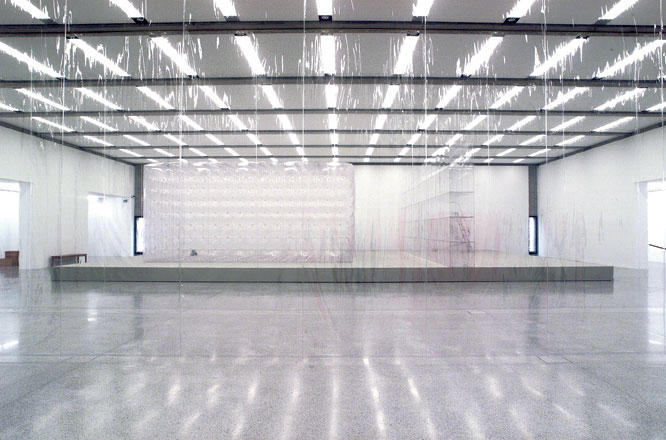Gerwald Rockenschaub

Calling Gerwald Rockenschaub’s exhibition at the Museum of Modern Art (MUMOK) a ‘retrospective’ seemed to be only partly justified. In a clever subversion of the genre, many of the exhibits were not actually old pieces but reworkings of earlier ones. It painstakingly avoided any patina of historical character and linear ‘artistic development’. Instead, the work on display felt like a single, synchronous whole. For a strict chronological documentation of his works from 1980 to 2004 the artist preferred to refer visitors to the catalogue.
The exhibition’s dry, prosaic title, ‘4296 m3’, was a straight description of the available space, which Rockenschaub chose to divide into a white cube and a black box. One conspicuous aspect of the exhibition design was the extent to which it guided the viewer, enforcing a carefully choreographed route that involved numerous dead ends. This mise-en-scène, generated a constant stream of fresh spatial effects.
Beginning the tour in Rockenschaub’s cinema, visitors to the exhibition found six animations projected side by side (every title is a description of the work: 2001, 6 animations, 6 DVD players): brightly coloured geometrical solids set in motion, like a Concrete art video game. These dancing forms, overwhelming at first, became agreeably challenging: it was possible to grasp the rhythm of these soundless loops. This music for the eye bore traces of both Rockenschaub’s interest in Techno and his early Neo-Geo painting.
The corridor connecting the two exhibition spaces was blocked off by a wall with a square opening at about eye level (2004, Wall Opening. 100x100 cm). The view through this ‘window’ from the black-painted room into the white cube was particularly spectacular: almost all of the objects were transparent, a crystal palace made from industrial materials. Seen from the white cube, on the other hand, the opening looked not unlike Kasimir Malevich’s Black Square (1915), with visitors’ faces appearing from time to time.
Dividing rooms is one of Rockenschaub’s pet strategies. Here the central gallery was divided by transparent curtains (2004, 2 PVC curtains, aluminium rails. 500x1900cm each) that formed corridors leading to the objects on view beyond. This is not the first time the artist has used this veiling ‘shower curtain’ effect: at his exhibition at the Bawag Foundation in 2001 the visitors’ path was completely blocked by a huge translucent cube. A softer version (2000, inflatable object, clear, translucent PVC sheeting, 320x680x440cm) stood in the MUMOK show, together with a wall made of hard, shiny cubes (2002, 85 acrylic cubes, clear, transparent. 350x190cm; 70x70x70cm each) and a ladder (1993, ladder podium, aluminium. 284x114x180cm) on a broad podium.
Windows and framing were a recurring motif in the show. As one example, the artist had two of the museum’s windows uncovered (2004, opening of the windows. 205x48cm each). Although a key element of the building’s façade, these narrow light sources have not been exploited in previous MUMOK exhibitions. In a side room Rockenschaub installed yet another partition wall (2004, wall, wood, painted white. 200x288x10cm) with an opening high up. Visitors reached it via a staircase (1993, 2 stair elements made of larch wood. 58x505x58cm each) – only to discover a matching staircase on the other side. This tautological set-up had a comically sobering effect: there was nothing to experience but the space itself. The only canvases on show, both dating from 1985, hung at the end of a tunnel-like room. These small images could be viewed only from a distance of several metres, as a red cord (2004, cotton cord, mounts. 265cm) prevented visitors from getting any closer.
Acutely aware of the history of engaging with ‘context’, a history of which he was part, Rockenschaub insisted once again in ‘4296 m3’ that the perception of art cannot be separated from the space in which it is displayed. His strength lies in the way he raises questions about the conditions for the act of presentation. Intended by the museum as one of its series of mid-career surveys, the show was used by Rockenschaub to stake out a convincing position. Entire strands of his oeuvre were omitted, but to see this as a falsification of history is to cling to a conventional definition of ‘retrospective’.













